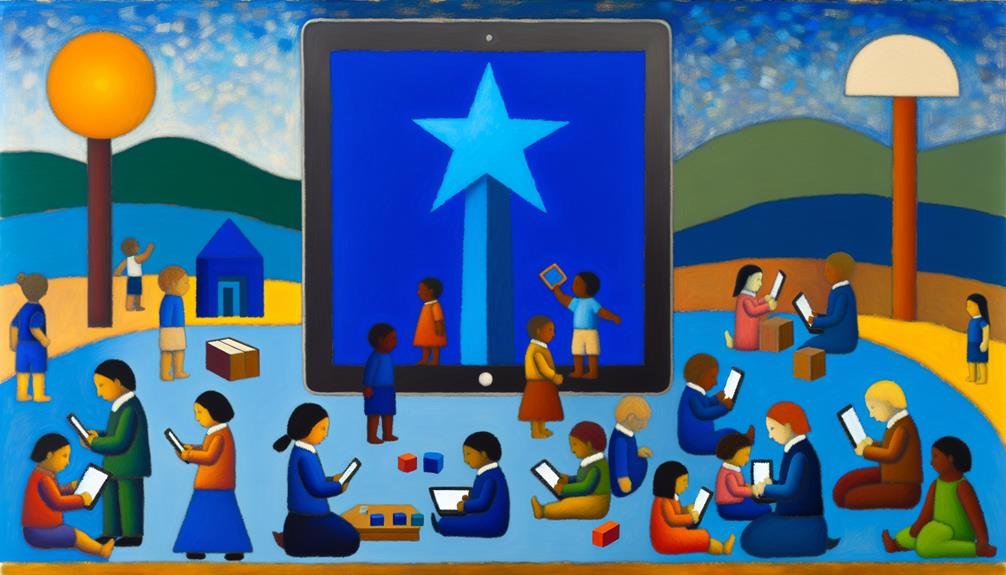Absolutely, let’s explore the exciting world of technology in early childhood education! Envision this: interactive learning experiences that make studying feel like playing. We’re talking educational games, virtual adventures, and personalized lessons that cater to your uniqueness. Imagine a place where robots teach you to code and dinosaurs come to life on screen. But hey, with great power comes great responsibility—too much screen time might make you a couch potato! It’s like walking a tightrope between fun and overdoing it. So, strap in, folks! The journey through the pros and cons of tech in education is a rollercoaster ride of discovery!
Takeaways
- Technology enhances interactive learning experiences, promotes cognitive development, and sparks creativity.
- Excessive screen time may displace essential activities, hinder imaginative play, and impact attention spans.
- Finding a balance between technology and experiential learning is crucial for healthy development.
- Screen time limitations foster social skills, prevent health issues, and maintain creativity.
- Technology equips children with essential tech skills for the future but should be used mindfully.
Benefits of Technology in Early Childhood Education
Utilizing technology in early childhood education has been shown to enhance interactive learning experiences and promote cognitive development in young children. From interactive educational games to multimedia presentations, technology offers a plethora of benefits in the classroom.
Picture this: a group of preschoolers gathered around a tablet, eagerly exploring virtual worlds that spark their imagination and curiosity. Through educational apps, children can learn letters, numbers, and even basic coding skills in a fun and engaging way.
Furthermore, technology allows for personalized learning experiences tailored to each child’s unique needs and learning style. With educational software tracking progress and adapting difficulty levels, children can learn at their own pace, fostering a sense of accomplishment and boosting self-esteem.
Additionally, the use of digital tools can help children develop essential 21st-century skills such as critical thinking, problem-solving, and digital literacy, preparing them for the future.
Enhanced Learning Opportunities
Technology in early childhood education provides enhanced learning opportunities that cater to individual needs and foster a dynamic educational environment. By incorporating interactive games, educational apps, and multimedia resources, technology makes learning engaging and personalized.
Imagine a classroom where each child can progress at their own pace, receiving immediate feedback and tailored challenges to keep them motivated and excited about learning.
Furthermore, technology allows educators to adapt teaching methods to suit different learning styles, ensuring every child has the chance to thrive. Whether it’s visual aids for visual learners, interactive simulations for kinesthetic learners, or audio resources for auditory learners, technology opens up a world of possibilities for enhancing learning experiences.
Moreover, technology can create a collaborative atmosphere where children work together on projects, share ideas, and learn from each other. Through virtual field trips, online discussions, and group projects, technology fosters teamwork and communication skills from an early age.
In this digital age, embracing technology in early childhood education can truly revolutionize the way children learn and grow.
Promotion of Creativity and Imagination

Exploring young learners to explore their creative potential and tap into their imagination is a fundamental aspect of integrating technology in early childhood education. Technology offers a myriad of tools and platforms that can spark creativity and enhance imaginative thinking in children. By incorporating interactive apps, educational games, and multimedia resources, educators can create engaging learning experiences that inspire kids to think outside the box.
Let’s investigate a fun comparison to highlight the impact of technology on creativity and imagination:
| Traditional Learning Methods | Technology-Infused Learning |
|---|---|
| Limited scope for creativity | Encourages interactive and creative exploration |
| Reliance on static materials | Dynamic and adaptable learning tools |
| Passive learning experiences | Active participation and engagement |
| Fixed outcomes | Room for experimentation and innovation |
Through this comparison, it’s clear that technology in early childhood education can act as a catalyst for fostering creativity and imagination in young minds. It provides a dynamic and interactive learning environment that nurtures innovation and original thinking.
Preparation for Future Technological Demands
As we prepare our little ones for the future, it’s essential to equip them with the necessary tech skills that will unquestionably be in high demand. By fostering digital literacy from an early age, we are setting them up for success in a world where technology reigns supreme.
Tech Skills Development
Developing early tech skills in childhood is essential for preparing young learners to meet the demands of an increasingly technology-driven future. In today’s digital age, where even a toddler can navigate a tablet better than some adults, equipping children with tech skills from an early age is like giving them a superpower cape for the future.
Think of it as planting the seeds of knowledge in the fertile soil of their young minds, ready to sprout into magnificent tech-savvy trees.
By introducing children to basic tech skills like using educational apps, coding games, or even simple robotics, we are shaping them into fearless explorers of the digital universe. These skills not only enhance their problem-solving abilities but also foster creativity and innovation.
Picture a group of young children huddled around a computer, collaborating to program a robot to perform a silly dance – that’s the magic of tech skills development in action.
Digital Literacy Importance
Introducing young children to digital literacy is imperative for equipping them with the necessary skills to navigate and thrive in an increasingly technology-driven world. It’s like giving them a treasure map to access endless possibilities!
Here are four reasons why digital literacy is vital for our little learners:
- Preparation for Future Jobs: In a world where even lemonade stands have gone digital, having a strong foundation in digital skills can open up a plethora of career opportunities for our tech-savvy kiddos.
- Enhanced Learning Experience: Digital literacy not only makes learning more interactive and engaging but also paves the way for personalized learning experiences tailored to each child’s unique needs.
- Critical Thinking Development: Exploring the digital landscape requires problem-solving skills and critical thinking, which are essential for our young ones to make informed decisions in the future.
- Global Connectivity: Through digital literacy, children can connect with peers worldwide, fostering cultural understanding and collaboration from a young age.
Concerns About Technology in Early Childhood Education

There is growing apprehension regarding the integration of technology in early childhood education due to concerns about its potential impact on young children’s development. While technology offers exciting possibilities for learning, some worry about the negative effects it may have on children’s social, emotional, and cognitive development.
One major concern is the potential for excessive screen time to displace essential activities like outdoor play and face-to-face interactions, hindering the development of important skills such as communication and socialization.
Additionally, there are worries about the long-term effects of technology on children’s attention spans and ability to focus on tasks without constant stimulation. Some fear that easy access to digital devices could lead to a decrease in creativity and imagination, as children may become reliant on technology for entertainment and problem-solving.
Despite these concerns, many educators and parents recognize the importance of finding a balance between using technology as a tool for learning and ensuring that children have ample opportunities for hands-on, experiential learning in the real world.
Screen Time and Limitations
Excessive screen time poses significant challenges for early childhood educators and parents seeking to balance technology use with real-world experiences in young children’s learning environments. While screens can offer valuable educational content, setting limitations is essential to guarantee children develop a well-rounded set of skills.
Here are four reasons why monitoring screen time is indispensable:
- Physical Health: Excessive screen time can lead to sedentary behavior, which is linked to health issues like obesity and poor posture.
- Social Skills: Limiting screen time encourages children to engage in face-to-face interactions, fostering social skills critical for their development.
- Creativity: Excessive screen use may hinder imaginative play and creativity, which are essential for cognitive growth.
- Sleep Quality: Blue light emitted by screens can disrupt sleep patterns, impacting children’s overall well-being and learning abilities.
Impact on Social Interactions and Development

Exploring the integration of technology in early childhood education has a notable impact on social interactions and developmental outcomes for young learners. While technology can enhance educational experiences, it also influences how children interact with their peers and surroundings. Let’s delve into the fascinating world of technology’s effects on social development.
In the table below, we’ll examine the pros and cons of technology in early childhood education when considering social interactions and developmental growth:
| Pros | Cons |
|---|---|
| Enhances communication skills | Potential for decreased empathy |
| Provides access to diverse resources | Risk of social isolation |
| Encourages collaboration | Dependency on screens |
| Fosters creativity and imagination | Reduced face-to-face interactions |
| Prepares for tech-driven future | Distraction from real-world experiences |
As we navigate the digital landscape in education, it’s essential to strike a balance that nurtures social skills while leveraging the benefits of technology. By being mindful of these aspects, we can create a well-rounded educational environment for our young learners.
Frequently Asked Questions
How Can Technology Help Children With Special Needs in Early Childhood Education?
Technology can assist children with special needs in early childhood education by providing personalized learning experiences, aiding in communication development, offering sensory stimulation, and facilitating skill-building through interactive apps and programs tailored to their unique requirements.
What Are the Risks of Over-Reliance on Technology for Young Learners?
Over-reliance on technology for young learners can hinder social development, limit physical activity, and impact attention spans. It may lead to decreased creativity, reliance on instant gratification, and potential negative effects on mental health.
Are There Any Ethical Considerations When Using Technology in Early Childhood Education?
Ethical considerations in early childhood education technology use encompass privacy, screen time limits, and ensuring technology supplements rather than replaces human interaction. Safeguarding children’s data and promoting healthy development are key priorities.
How Can Parents and Teachers Find a Balance Between Traditional and Tech-Based Learning?
To strike a balance between traditional and tech-based learning, parents and teachers can integrate hands-on activities, outdoor play, and interactive technology. By combining both methods, children can develop a well-rounded set of skills and knowledge.
What Measures Are in Place to Ensure the Safety and Privacy of Children Online?
Ensuring the safety and privacy of children online involves implementing strict data protection measures, educating both children and parents about online risks, utilizing secure platforms, regularly monitoring online activities, and adhering to established laws and regulations.
Conclusion
To sum up, while technology in early childhood education offers many benefits such as enhanced learning opportunities and preparation for future demands, it also raises concerns about screen time and social interactions.
It is important for educators and parents to strike a balance between utilizing technology as a tool for learning and ensuring that children have opportunities for hands-on, interactive experiences.
By carefully monitoring and managing technology use, we can create a well-rounded educational environment for our young learners.

